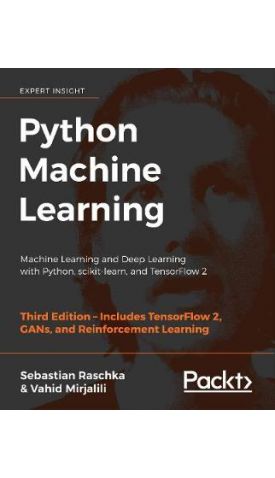אנו משתמשים ב-Cookies כדי לשפר את החוויה שלך. כדי לקיים ההנחיה החדשה של e-Privacy, עלינו לבקש את הסכמתך להגדיר את ה-Cookies. קבלת מידע נוסף.
198.00 ₪
Python Machine Learning 3E
198.00 ₪
ISBN13
9781789955750
יצא לאור ב
Birmingham
מהדורה
3rd Revised edition
עמודים
770
פורמט
Paperback / softback
תאריך יציאה לאור
31 באוק׳ 2019
Python Machine Learning, Third Edition is a comprehensive guide to machine learning and deep learning with Python. Packed with clear explanations, visualizations, and working examples, the book covers all the essential machine learning techniques in depth. This new third edition is updated for TensorFlow 2 and the latest additions to ...
Applied machine learning with a solid foundation in theory. Revised and expanded for TensorFlow 2, GANs, and reinforcement learning.
Key Features
Third edition of the bestselling, widely acclaimed Python machine learning book
Clear and intuitive explanations take you deep into the theory and practice of Python machine learning
Fully updated and expanded to cover TensorFlow 2, Generative Adversarial Network models, reinforcement learning, and best practices
Book DescriptionPython Machine Learning, Third Edition is a comprehensive guide to machine learning and deep learning with Python. It acts as both a step-by-step tutorial, and a reference you'll keep coming back to as you build your machine learning systems.
Packed with clear explanations, visualizations, and working examples, the book covers all the essential machine learning techniques in depth. While some books teach you only to follow instructions, with this machine learning book, Raschka and Mirjalili teach the principles behind machine learning, allowing you to build models and applications for yourself.
Updated for TensorFlow 2.0, this new third edition introduces readers to its new Keras API features, as well as the latest additions to scikit-learn. It's also expanded to cover cutting-edge reinforcement learning techniques based on deep learning, as well as an introduction to GANs. Finally, this book also explores a subfield of natural language processing (NLP) called sentiment analysis, helping you learn how to use machine learning algorithms to classify documents.
This book is your companion to machine learning with Python, whether you're a Python developer new to machine learning or want to deepen your knowledge of the latest developments.
What you will learn
Master the frameworks, models, and techniques that enable machines to 'learn' from data
Use scikit-learn for machine learning and TensorFlow for deep learning
Apply machine learning to image classification, sentiment analysis, intelligent web applications, and more
Build and train neural networks, GANs, and other models
Discover best practices for evaluating and tuning models
Predict continuous target outcomes using regression analysis
Dig deeper into textual and social media data using sentiment analysis
Who This Book Is ForIf you know some Python and you want to use machine learning and deep learning, pick up this book. Whether you want to start from scratch or extend your machine learning knowledge, this is an essential resource. Written for developers and data scientists who want to create practical machine learning and deep learning code, this book is ideal for anyone who wants to teach computers how to learn from data.
| מהדורה | 3rd Revised edition |
|---|---|
| עמודים | 770 |
| פורמט | Paperback / softback |
| ISBN10 | 1789955750 |
| יצא לאור ב | Birmingham |
| תאריך יציאה לאור | 31 באוק׳ 2019 |
| תוכן עניינים | Table of Contents Giving Computers the Ability to Learn from Data Training Simple ML Algorithms for Classification ML Classifiers Using scikit-learn Building Good Training Datasets - Data Preprocessing Compressing Data via Dimensionality Reduction Best Practices for Model Evaluation and Hyperparameter Tuning Combining Different Models for Ensemble Learning Applying ML to Sentiment Analysis Embedding a ML Model into a Web Application Predicting Continuous Target Variables with Regression Analysis Working with Unlabeled Data - Clustering Analysis Implementing Multilayer Artificial Neural Networks Parallelizing Neural Network Training with TensorFlow TensorFlow Mechanics Classifying Images with Deep Convolutional Neural Networks Modeling Sequential Data Using Recurrent Neural Networks GANs for Synthesizing New Data RL for Decision Making in Complex Environments |



Login and Registration Form